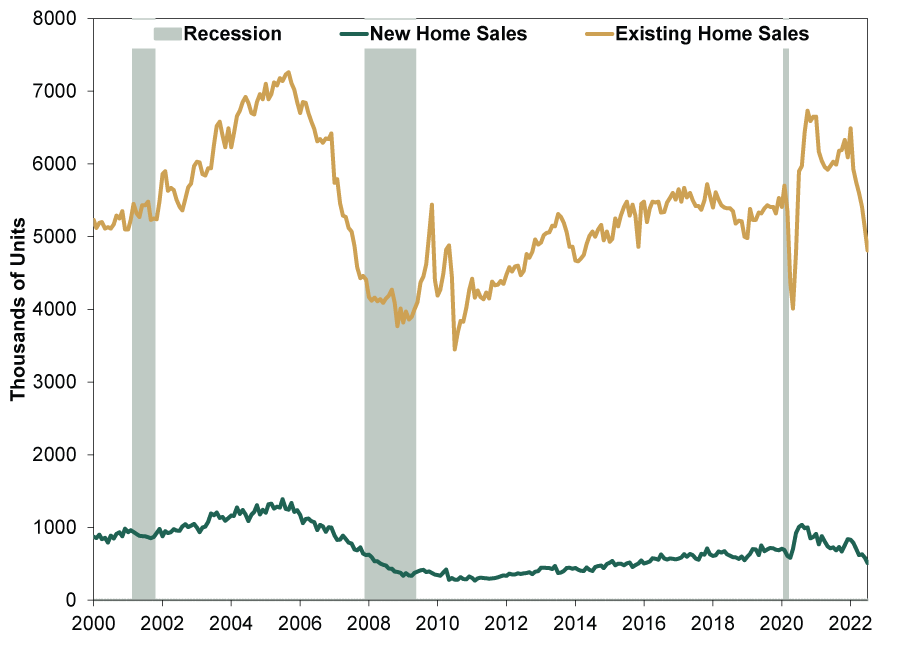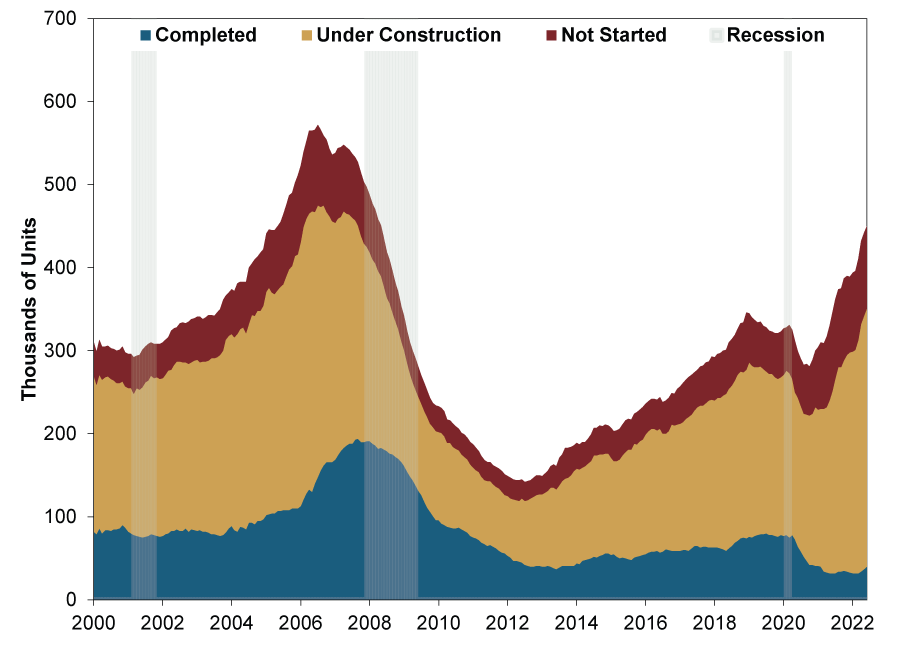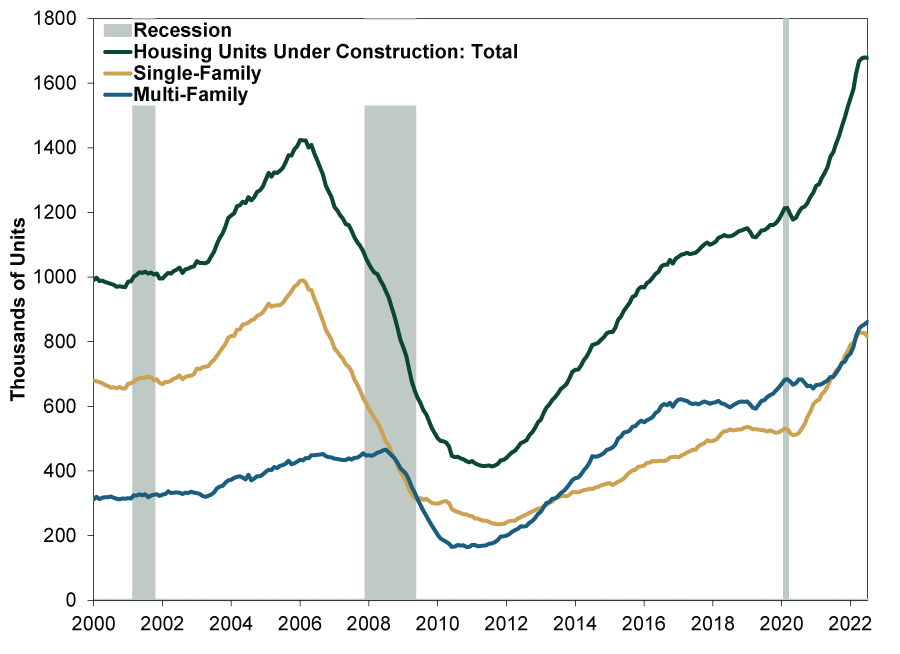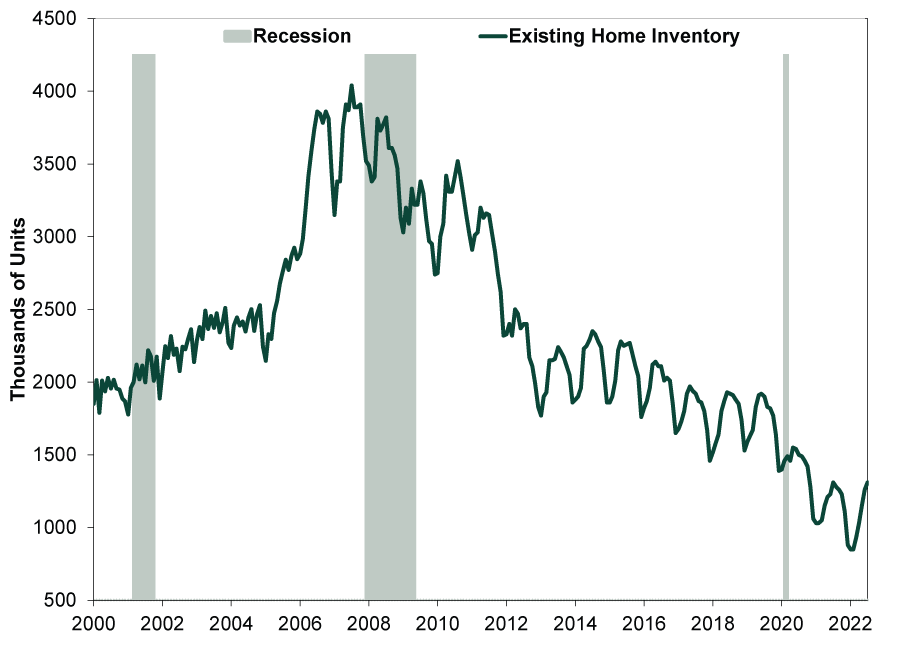Personal Wealth Management / Market Analysis
Will a ‘Housing Recession’ Spur Wider Economic Contraction?
A housing crash delivering a new hit to stocks isn’t very likely, in our view.
Last week, the National Association of Home Builders’ August survey suggested its members’ sales conditions are starting to deteriorate as mortgage rates have doubled from last year, leading it to declare a “housing recession” is underway. Besides ongoing supply chain problems hiking construction costs, builders noted cancellations are spiking. With inventories rising, housing starts slowing and reports of sellers slashing prices to attract balking buyers, alarm over a potential residential real estate collapse is growing. Many fear such a downturn could hit the economy hard—and send stocks slumping anew. But although the housing market may be weakening, we don’t expect stocks to mind much.
The housing market has indeed hit a rough patch. Home sales have dropped sharply.
Exhibit 1: Home Sales Sinking
Source: FactSet, as of 8/24/2022. Census Bureau new privately owned houses sold and National Association of Realtors existing homes sold, January 2000 – July 2022.
Partly as a result, the inventory of new houses for sale has climbed rapidly.
Exhibit 2: New Home Inventory Pipeline Swelling
Source: FactSet, as of 8/24/2022. New privately owned houses for sale by stage of construction, January 2000 – July 2022.
In turn, seeing inventories on the rise amid weakening sales, builders are responding. After rising steadily the last few years, new home construction appears to be peaking.
Exhibit 3: New Construction Starting to Slow?
Source: Federal Reserve Bank of St. Louis, as of 8/24/2022. Total, single-family and multi-family new privately owned housing units under construction, January 2000 – July 2022.
Given this backdrop, some fear residential investment is set to tank, perhaps taking down purchases of durable goods like furniture and appliances with it. But before you start harkening back to 2006, consider: While they have increased, existing home inventories remain historically low—very different from the 2000s’ latter half. Furthermore, inventory growth has slowed lately—it was flat year-over-year in July.
Exhibit 4: Existing Home Inventory Historically Low (Even Without Seasonal Adjustment)
Source: FactSet, as of 8/24/2022. National Association of Realtors inventory of existing homes for sale, January 2000 – July 2022. Not seasonally adjusted, hence the repeatedly choppy pattern.
What about all those new homes coming down the pike? New home supply has apparently leapt—but that is largely an artifact of supply chain constraint skew. As Exhibit 2’s underlying breakdown reveals, most is under construction (yellow) and not yet started (red). Completed homes for sale (blue) are still below nearly all levels pre-pandemic.
Builders may choose to pause starts and delay construction, awaiting further clarity on supply and demand dynamics. As new home construction is the primary way housing contributes to GDP, that seemingly happened in Q2. Residential investment fell -16.2% annualized last quarter, shaving -0.83 percentage points off headline GDP growth.[i] As supply and demand adjust further, housing activity could slip more this quarter. Hence, all the focus on builders’ outlooks.
However, don’t overrate this. Many think real estate drives a huge chunk of the economy, but in reality, residential investment is only 3.4% of GDP.[ii] Its economic footprint has been shrinking, too. Two decades ago, housing stood around 5% of GDP.[iii] Even if you expand today’s share to include spending on goods like appliances and furniture, it increases to just 5.9%.[iv] And that likely overstates things, considering it is a vast exaggeration to presume all appliance and furniture purchases are real estate related.
Residential investment can swing greatly, but other components like business investment have much larger influence—and move independently from the housing cycle. Its sector weighting also reflects this. Real Estate’s market capitalization, which includes commercial property developers, is less than 3% of the S&P 500’s.[v] Household Durables, a Consumer Discretionary sub-sector that contains Homebuilders, is only 0.3%.[vi] This is why past housing downturns haven’t automatically driven recessions or bear markets (typically prolonged and fundamentally driven declines exceeding -20%). Since quarterly GDP data start in 1947, residential investment has fallen in 119 of 301 quarters.[vii] Yet only 34 of these coincide with declining overall GDP. That just shows it is a very volatile subcategory. Similarly, weak residential investment, like the decline in four of six quarters from Q3 2017 – Q4 2018, didn’t coincide with recession or contracting GDP. Ditto for four straight quarterly drops from Q3 1994 through Q2 1995.
The popular misunderstanding of 2007 – 2009 makes people believe residential real estate has huge sway. But that isn’t what caused prolonged recession. Even here, declining investment began not in late 2007 or 2008, but Q4 2005.[viii] Rather, a misapplied “mark-to-market” accounting rule, implemented in 2007, caused banks to write down illiquid, held-to-maturity assets (that largely paid out just fine in the end) to fire-sale values as hedge funds liquidated similar assets. That wiped out bank capital, which, combined with the government's haphazard crisis response, led to 2008’s financial crisis and subsequent deep recession. Today, such a transmission mechanism is absent. Banks’ held-to-maturity assets aren’t subject to mark-to-market accounting—plus loan underwriting standards and credit quality are much higher, as niche lenders have taken over much of the mortgage market.
So no, residential real estate doesn’t look fantastic lately. But extrapolating this into a much broader crisis is a stretch, in our view. It is a volatile economic category with less impact than many suspect. Furthermore, because it is so widely watched, even if the housing market declines further, it probably wouldn’t shock anyone. As surprise moves stocks most, we doubt any “housing recession” will be a big stock market driver.
[i] Source: Bureau of Economic Analysis (BEA), updated as of 8/25/2022, according to the BEA's second “preliminary” GDP estimate. Residential investment, Q2 2022.
[ii] Source: Federal Reserve Bank of St. Louis, as of 8/24/2022. Residential investment as a percent of GDP, Q2 2022.
[iii] Source: Federal Reserve Bank of St. Louis, as of 8/24/2022. Residential investment as a percent of GDP, Q2 2002.
[iv] Source: Federal Reserve Bank of St. Louis, as of 8/24/2022. Residential investment, furnishings and durable household equipment as a percent of GDP, Q2 2022.
[v] Source: FactSet, as of 8/24/2022. Real Estate market capitalization as a percent of the S&P 500’s, 8/23/2022.
[vi] Source: FactSet, as of 8/24/2022. Household Durables market capitalization as a percent of the S&P 500’s, 8/23/2022.
[vii] Source: BEA, as of 8/24/2022.
[viii] Ibid.
If you would like to contact the editors responsible for this article, please message MarketMinder directly.
*The content contained in this article represents only the opinions and viewpoints of the Fisher Investments editorial staff.
Get a weekly roundup of our market insights
Sign up for our weekly e-mail newsletter.

You Imagine Your Future. We Help You Get There.
Are you ready to start your journey to a better financial future?

Where Might the Market Go Next?
Confidently tackle the market’s ups and downs with independent research and analysis that tells you where we think stocks are headed—and why.









